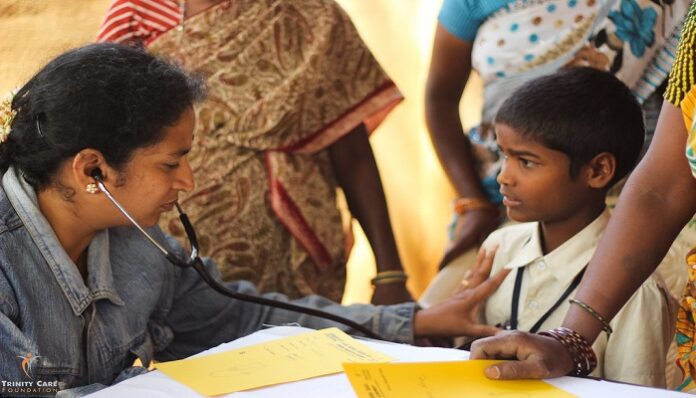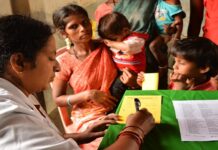Abstract
Traditional beliefs and practices related to health are prevalent in every society. Medical and clinical research are significant for understanding health and illness of a person. But at the same time, the socio-cultural factors which are shaped by the culture in which one lives play a crucial role in understanding health in a holistic manner. The risk of illness is increased by many social and cultural factors and it directly or indirectly influences the way a person defines and treats illness. Hence, individual behaviour related to health is determined more or less by social and cultural differences among the individuals. The objective of this articleis to understand the socio-cultural aspects influencing health. It concludes how socio-cultural factors influencing the health seeking behaviour of the population play a vital role in public health..
Introduction
Health is a fundamental concept and is a significant part of our living. There are different interpretations of health by different groups and societies. Health is basically a resource which helps an individual to lead a productive life. According to the World Health Organization (WHO), “Health is a state of complete physical, mental and social well-being and not merely absence of disease.” Though this definition of health is widely accepted, it also has some limitations. Like there is an absence of measurable terms and this definition is confined to ‘state’ instead of seeing it as a process in which people adjust to changing environment and demands of life.
Health involves various factors from personal behaviour, genetic inheritance, accessibility to health care, external environment including air, water etc. There are several social determinants which affects the life of an individual at multiple levels. For instance, poverty impacts different individuals differently at various stages like infancy, childhood, pregnancy, and old age. There are also certain social and cultural variables which directly or indirectly impact health seeking behaviour of a population like race, gender, poverty, sex roles, and work environment, in addition to certain characteristics like social cohesion, social capital, and distribution of income, which are closely associated to the health of an individual.
Socio-cultural dimensions of health deal with both social and cultural dimensions of public health. It also deals with the inter-linkage between the two. Social dimensions involve linking public health with standard of living, role of public health in overall development of society, and it also deals with the association of public health with equality. The cultural dimension deals with cultural frames that shapes the perceptions of an individual. Cultural differences affect patients’ attitude towards medical care and their ability to understand, manage and cope with illness. In our multicultural society, different customs can lead to confusion and misunderstanding which erode trust and patient adherence.
Concepts of Health
As said by Democritus, “Without health nothing is of any use, not money nor anything else”. Health is not a static but a dynamic concept, as it consists of multiple meanings. Each person defines health in accordance to one’s own personal knowledge, social and illness experience. There are various approaches to health for understanding health in a detailed manner: Biological approach, which deals with tissues, organs, organisms, genetics etc.; Biomedical approach deals with pathology; Behavioural approach deals with risk factors, lifestyle behaviours; Determinants approach deals with broader conditions of society like cultural, social, and structural conditions. A Public health approach deals with measures in order to protect one’s health, promoting health and preventing diseases. It is interesting to know that none of these approaches are valid universally however, they have overlapping factors.[1]
Health Equity and Inequity (Social Justice)
According to Kawachi, Subramanian and Almeida-Filho[1] it is significant to understand how social injustice leads to inequity and at the same time understanding the difference between inequality and inequity.[5] ‘Health inequality,’ irrespective of the cause measures the difference in health status among individuals, groups or populations while ‘health inequity’ are those inequalities which has its roots from some form of injustice. Health equity deals with rights of an individual to have equitable access to services based on their needs and various factors that determine their health and well-being like resources, capacities, power etc. Basically ‘health equity’ implies equal distribution of resources based on needs. For understanding ‘health as a human right’, this social justice approach forms the foundation of health systems.[1]
Socio-Cultural Perspectives on Health and Illness
Culture comprises of different beliefs, behaviours which are shared among the members of society, it gives direction to a person whether something is right or wrong. Culture influences the decisions taken by an individual in various ways and therefore it is necessary to understand the patient’s cultural background to provide quality health care. Some of the psychosocial factors include social support, optimism, feeling of control which are beneficial for an individual for self-assessing one’s own health status.
Research carried out to understand how culture affects the health seeking behaviour of an individual found out that 45% of adults believed that illness was caused due to the ‘will of god,’ 26% believed that past sins were the reason for causing T.B, 48% believed that ghost intrusion leads to epilepsy and 36% believed that ‘karma’ is the reason for causing a disease. This shows how socio-economic status, traditions, beliefs and other cultural factors influence the spread of disease.[2]
Socio-Cultural Interpretative Dimensions of Health & Illness
The medical models of culture shapes and influences an individual’s mental representation of illness. “The popular knowledge on illness” is the term often used for social and cultural beliefs and this domain of individual’s perceptions due to cultural differences revolves around ‘causal contributions of health and illness.’ In order to find out the significance of pathology for an individual it is crucial to understand the ‘health folklore’ which consists of cultural factors including all the information of health issues which an individual acquires from family, friends and neighbours. This information would be highly beneficial for solving those cases which have minimum therapeutic success rate.[3]
Every individual through his or her culture is acquainted with certain pre-set values and attitudes, right from symptoms to evaluation of an illness, and sometimes this illness is described in such a manner that it negotiates both personal expectations and socio-cultural rules. This knowledge about the socio-cultural characters is essential to avoid mistakes in therapeutic, diet and lifestyle recommendations.
There are various theories related to ‘adjustment to illness,’ which suggests how the way in which one perceives his or her illness shapes their coping skills. This mechanism is better explained by ‘Lazarus stress and coping theory’ which deals with two coping strategies, one is ‘acceptance’ and the other is ‘avoidance.’ Acceptance includes various factors like social support, identifying benefits, seeking information, creating commodity markets for emotional expression. While avoidance includes factors like denial, suppression, disengagement etc.[4]
‘Medical Anthropology’ is the field which helps to reveal the ‘folk’ beliefs in various cultures and the associated health behaviour. This domain helps to understand illness not only in terms of biological reference but also its social, political and cultural dimensions. Some of the components of this are attitude towards a disease, adherence to treatment, late visit to a doctor etc. For Instance, in Romania, the traditionalist belief system considers family interests and honour more important than the individual family member, so if any member suffers from genetically transferred disease they are refused to be treated as treatment of this disease will reduce the chances of marriage of girls in that family for being carriers.[6]
Another modern component of Health services includes ‘Patient Focused Communication’ which includes patient perspective, psychosocial context, joint understanding and change of power and responsibility. This ‘Patient Focused Communication’ is perceived by Stewart (2001)[7] as a holistic concept which keeps on becoming better with every doctor-patient meeting. Therefore, the socio-cultural specific character is an essential part for understanding illness in a holistic way.[7]
Socio-Cultural Aspects of Health and Disease and their Pragmatic Impact
According to Sabrina Alaide Amorem Alves and Maryles Lucena Bezzere de Oliveira,[8] there is a strong association between life process of human beings and different socio-cultural factors. For achieving health equity, different strategies are formulated for addressing these disparities related to the socio-cultural factors. These factors are found in different areas related to health, for example, human immune deficiency virus (HIV), which is the most stigmatized area. Understanding of these factors is essential for health-related treatment. The thematic categories related to health are divided into 2 categories: one is socio-cultural aspects in health and disease and the other is influence of these socio-cultural aspects in construction of public health. These social factors include work environment, housing conditions, living conditions, hygiene etc. While construction of public health involves population wide policies, promoting behaviour change, media, strengthening the organization and participation of people.
1. Socio-cultural aspects of health and disease:
This relation between health and social factors is crucial for understanding factors affecting the health situation of a population. The social aspects of health include various factors like behaviour, ethnicity, economic situation, culture, etc. Health promotion was an idea promoted through ‘social medicine’ concept which was associated with social justice, democracy, citizenship, participation etc. Cultural aspect of the social factor can be best understood by ‘mental health’ with example of schizophrenia, the prejudgement associated with it in society and health care.
2. Influence of socio-cultural aspects in construction of public health:
The field of health suffers from problems like communication deficiencies and non-compliance to treatment due to several cultural factors. Some of these factors are related to sexuality, women often express discomfort when it comes to sexuality and intimate aspects. Religion is another important factor. Stigmatization of mental health is another instance where often social exclusion is an obstacle in the treatment of a mental illness.[8]
Conclusion
In this article, we discussed factors which are important to be identified as they help to understand the way in which society functions in terms of health affecting the individual. We discovered various elements like health equity and inequity; socio-cultural perspectives on health and illness, which includes belief, behaviour; socio-cultural interpretative dimension of health and illness which includes cultural factors, pre-set values, attitudes, coping skills, medical anthropology, patient focused communication; pragmatic impact of socio-cultural aspect of health, which includes policies promoting behaviour change. Socio-cultural aspects are an important part in formulation of public policies which consequently affect public health. Identification and orientation of such socio-cultural aspects pave the way in managing health-seeking behaviour of an individual. There are many questions that remain unanswered about how social and cultural environments contribute to health. However, this article gives an overview of the various components which cover the socio-cultural dimension of health.
References
1. Keleher H, MacDougall C. Understanding health. Oxford University Press; Ch1 (Pt1), 3 p.
2. Nayak MG, Sharada, Geroge A. Socio-Cultural perspectives on health and illness. Nitte University Journal of Health Science. 2012;2(3):61-7.
3. Enachescu I, Sadean I. Socio-cultural interpretative dimensions of health and illness. AFASES.2013;1.
4. Iamandescu IB. Psychosomatics today-after its semantic dissolution. Info Medica 2008; 1(143):5.
5. KawachiI, Subramanian SV, N Almeida-Filho N.A glossary for health inequalities. J Epidemiol Community Health.Sep 2002;56(9):647-652.
6. Epstein RM, Franks P, Fiscella K, Shields CG, Meldrum SC, Kravitz RL, Duberstein PR. Measuring patient-centered communication in patient–physician consultations: theoretical and practical issues. Social Science & Medicine.2005;61:1516-1528.
7. Alves SA, de Oliveira ML. Sociocultural aspects of health and disease and their pragmatic impact. Journal of Human Growth and Development. Jun 2018;28(2):183-8.
8. Kleinman A, Becker AE. “Sociosomatics”: the contributions of anthropology to psychosomatic medicine. Psychosomatic medicine. Jul 1998;60(4):389-93.
+

























